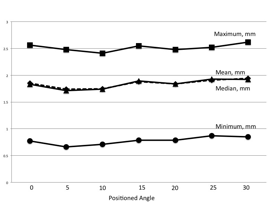Session Information
Session Type: Abstract Submissions (ACR)
Background/Purpose: Joint space narrowing is an important outcome measure in rheumatoid arthritis, linked tightly to function and disability. High-resolution peripheral quantitative computed tomography (HR-pQCT) allows detection of bone margins with high precision. Based on this capability, we have devised a software script to quantify volumetric joint space width based on the method of ‘fitting maximal spheres’. The reproducibility of this method may be affected by the angular positioning of the joint. Our study assesses variability of 3D volumetric joint space measurements with variations in joint flexion between 0 and 30 degrees.
Methods: The 2nd and 3rd MCP joints of six cadaver hands were imaged with HR-pQCT (n=12 joints). Using a positioning device, the MCPs were placed at 7 different angles of flexion (0, 5, 10, 15, 20, 25 and 30 degrees). Actual angles of acquisition were verified in the sagittal plane post-hoc. Descriptive statistics were used to calculate the mean, median, minimum, and maximum joint space widths and total volume measurements, by degree of angulation. The coefficient of variation (root-mean-square deviation), CV(RMSD), was calculated to determine the variability caused by angulation.
Results: There was little variation in positioned angle and post-hoc angle measurement up to 15 degrees of flexion (measured angle mean 2.1, 5.7, 10.7, 15.3 vs positioned angle 0, 5, 10 and 15 respectively). At greater degrees of flexion, positioning error was significant, with the post-hoc angle measurement ranging from 20.8 to 32.5 at 30 degrees. Mean, median, maximum and minimum joint space increased linearly between 5 and 30 degrees (Figure 1). The CV(RMSD) was optimized between 5 and 15 degrees of flexion (Table 1). Minimum joint space measurements were highly variable at all degrees of flexion.
Figure 1. Plot of Obtained Measurements by Degree of Angulation
|
Table 1. Coefficient of Variation (Root-Mean Square Deviation) for Joint Space Measurements by Angle of Flexion of the MCP Joints |
|||||
|
Angles |
Mean |
Median |
Minimum |
Maximum |
Volume |
|
0-10 |
4.8% |
5.2% |
14.6% |
4.0% |
3.2% |
|
0-15 |
5.0% |
5.9% |
20.2% |
4.5% |
3.8% |
|
5-15 |
4.4% |
5.5% |
18.0% |
4.3% |
3.4% |
|
0-20 |
5.4% |
6.7% |
22.4% |
5.0% |
4.2% |
|
0-25 |
6.1% |
7.3% |
35.8% |
5.3% |
5.2% |
|
0-30 |
6.7% |
7.5% |
35.9% |
5.7% |
5.2% |
Conclusion: Our 3D volumetric measurement method of joint space width for images acquired with HR-pQCT technology is reliable for MCP flexion angles of 0 to 20 degrees. Reproducibility metrics are optimized between 5 and 15 degrees. Care should be given to remaining in this parameter for longitudinal or repeated measures studies using this technology for joint space width assessment.
Disclosure:
C. Barnabe,
None;
S. Manske,
None;
B. Jorgenson,
None;
S. K. Boyd,
None.
« Back to 2014 ACR/ARHP Annual Meeting
ACR Meeting Abstracts - https://acrabstracts.org/abstract/optimal-hand-position-for-reliable-volumetric-joint-space-width-measurements-using-high-resolution-peripheral-quantitative-computed-tomography/

